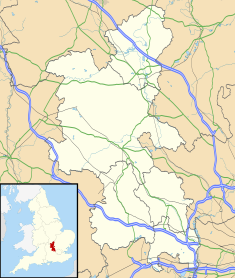High Wycombe Town Hall
| High Wycombe Town Hall | |
|---|---|
 High Wycombe Town Hall in 2012 | |
| Location | High Wycombe, Buckinghamshire |
| Coordinates | 51°37′40″N 0°44′58″W / 51.6278°N 0.7494°WCoordinates: 51°37′40″N 0°44′58″W / 51.6278°N 0.7494°W |
| Built | 1904 |
| Architect | Charles Bateman and Alfred Hale |
| Architectural style(s) | Queen Anne style |
Listed Building – Grade II | |
| Designated | 29 January 1996 |
| Reference no. | 1246257 |
 Location of High Wycombe Town Hall in Buckinghamshire | |
High Wycombe Town Hall is a public building located on Queen Victoria Road in High Wycombe, Buckinghamshire, England. It is a Grade II listed building.[1]
History[]

The building was commissioned to replace the 18th century guildhall in the High Street.[2] The foundation stone for the new building was laid by the mayor, Daniel Clarke, on 5 November 1903.[3] The building was designed by Charles Bateman and Alfred Hale in the Queen Anne style and was officially opened on 12 October 1904.[1]
The design involved seven bays with a central doorway flanked by Ionic order columns and segmented windows in the bays.[1] The design for the first floor involved tall windows, while the attic storey had round windows at either end.[1] On the roof was a clock turret with cupola above.[1] Internally, the principal room on the first floor was the Oak Room, which was heavily panelled and featured stained glass windows depicting local people: the philosopher, Edmund Burke, the former Prime Minister, Benjamin Disraeli, the English Civil War Parliamentarian, John Hampden, and the founder of Pennsylvania, William Penn.[1]
Additional accommodation in the form of municipal offices, designed by R G Brocklehurst and Charles Cowles-Voysey in the neo-Georgian style, were built on the opposite side of Queen Victoria Road in 1931.[4] The architects were awarded a bronze medal by the Royal Institute of British Architects for the design of the municipal offices.[5] The town hall was used as an events venue rather than for civic affairs and rock performers included The Rolling Stones in 1963,[6] The Who in 1965[7] and Joy Division in 1980.[8]
Council meetings of the municipal borough of High Wycombe were still held in the guildhall into the late 1920s and it was not until the early 1930s that council meetings moved to the council chamber in the municipal offices.[9] After the municipal borough was abolished under the Local Government Act 1972,[10] the successor body, Wycombe District Council, continued to make use of the council chamber in the municipal offices[11] and that building was restyled "the District Council Offices".[12] The town hall became surplus to requirements and was subsequently absorbed into the Wycombe Swan entertainment complex.[13]
References[]
- ^ a b c d e f Historic England. "Former town hall (1246257)". National Heritage List for England. Retrieved 20 August 2020.
- ^ "The buildings of Wycombe: The former Town Hall". Bucks Free Press. 23 April 2011. Retrieved 20 August 2020.
- ^ "High Wycombe Town Hall: Foundation Stone". Retrieved 20 August 2020.
- ^ "High Wycombe Historic Towns Assessment Report" (PDF). Wycombe District Council. p. 74. Retrieved 20 August 2020.
- ^ "Bronze RIBA Architectural medal awarded to Charles Cowles-Voysey and R G Brocklehurst". The Saleroom. Retrieved 20 August 2020.
- ^ "The Rolling Stones". Tamworth Bands. Retrieved 20 August 2020.
- ^ "High Wycombe Town Hall". The Who Live. Retrieved 20 August 2020.
- ^ "Joy Division concert: 20 February 1980: Town Hall, High Wycombe". www.joydiv.org. Retrieved 2021-11-17.
- ^ "The Old, The New, and the In-Between" (PDF). The Wycombe Society. 2014. p. 3. Retrieved 20 August 2020.
- ^ Local Government Act 1972. 1972 c.70. The Stationery Office Ltd. 1997. ISBN 0-10-547072-4.
- ^ "Planning Committee" (PDF). Wycombe District Council. 15 January 2020. Retrieved 20 August 2020.
- ^ "Of Georgian Town Houses, a Labrador and Errant Cars" (PDF). High Wycombe Society. 2005. p. 10. Retrieved 20 August 2020.
- ^ "The Swan Theatre, St Mary Street, High Wycombe, Buckinghamshire". www.arthurlloyd.co.uk. Retrieved 20 August 2020.
- High Wycombe
- Grade II listed buildings in Buckinghamshire
- Government buildings completed in 1904
- City and town halls in Buckinghamshire
